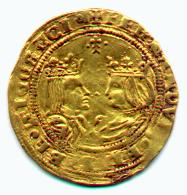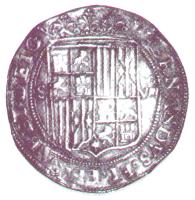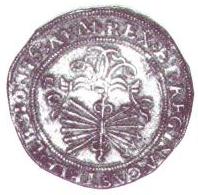
Medina
del Campo a 13 de Junio de 1497 ![]()
|
Fernando e |
|
Ferdinand & Elizabeth (Isabella) | |
|
Uno de los lideres más exitosos de toda la historia, Isabel dirigió el futuro de España con perspicacia y previsión. Fernando e Isabel se unieron en matrimonio, fe y política, aun cuando cada uno de ellos guardó el control de sus reinos, Fernando el reino de Aragón e Isabel los reinos de Castilla y León. La unión de los "Españas" en un solo país es bien conocida, al igual que la reconquista de España sobre los musulmanes en 1.492, el mismo año que Fernando e Isabel patrocinaron las exploraciones de Colón que condujeron al descubrimiento y dominación de un extenso nuevo mundo. En lo que a monedas se refiere, los monarcas católicos realizaron grandes cambios. Cuando ascendieron al poder no había una moneda íntegra lo cual sofocaba el comercio: sólo en Castilla había 150 cecas, cada una de ellas beneficiando a su propietario quien rebajaba aún más la moneda. El nuevo sistema de acuñación puso nuevamente vida al comercio, y conjuntamente con los muchos otros cambios que realizaron, permitieron recuperar la economía nacional. La reforma de la moneda permitió al sistema monetario administrar la enorme inundación del metal precioso que llegaría en abundancia desde América. Tomado de Ferdinand and Isabella por Prescott, "Los autores de ese día son ilimitados en sus aplausos de Isabel, a los cuales atribuyen principalmente a esta revolución propicia en la condición del país y de sus habitantes, que se parece casi tan mágico como una de esas transformaciones en labrado aventura por las manos de alguna hada benévola.... "Éste... aparece haber sido el resultado natural de la política de Fernando e Isabel, fue derivado absolutamente tanto de la influencia de sus caracteres privados, como de sus medidas públicas. Sus talentos reconocidos fueron utilizados por una conducta dignificado, que formó un contraste llamativo con la vileza en la mente y las maneras, que habían distinguido a su precursor. Exhibieron una sabiduría práctica en sus propias relaciones personales, que siempre el respecto de los comandos, y que, no obstante puede tener sabrosado de la política en Ferdnando, en su consorte, fue fundado en el más puro y más exaltado principio. Bajo tal soberano, la corte, que había sido poco mejor que un burdel bajo reinado precedente, se convirtió en el cuarto de niños de la virtud y de la ambición abundante. Asiduo excedente mirado Isabel la consolidación de los damiselas alto-llevados de su corte, que ella recibió en el palacio real, haciéndolos ser educado bajo su propio ojo, y dotándolos con las porciones liberales en su unión. Por éstos y actos similares del solicitude cariñoso, ella se hizo querer por las clases más altas de ella los temas, mientras que la tendencia patriótica de su conducta pública la estableció en los corazones del peo... "...ella se esforzó para atar juntos los fragmentos desunidos del estado, para asignar a cada uno de sus grandes divisiones sus límites constitucionales, y, presionando el aristocracy a su nivel apropiado y elevando el público, para consolidar el conjunto bajo la supremacía legal de la corona."1 Una
hija de los monarcas católicos, Juana, fue casada con Felipe el Hermoso,
hijo de Maximiliano I de la casa de Habsburgo. Como la historia pudo
revelar, esta unión habría de representar una enorme importancia para
España, porque produjo un niño, Carlos, que llegó a ser amo y señor de
inmensos dominios, un imperio en el cual "no se ponía el sol”. Además de esta historia, extremadamente abreviada, relacionamos la información sobre la reforma de la moneda que incluyó las especificaciones para el real de plata y sus múltiplos (reales de a 2, 4, y 8). Se ilustra arriba una moneda de oro de 2 Excelentes de Fernando e Isabel hecha con las especificaciones (no registradas aquí) de ley. |
One of the most successful leaders in all of history, Elizabeth directed the future of Spain with insight and with foresight. Ferdinand and Elizabeth were united in marriage, faith and politics, yet they each kept control of their individual kingdoms, Ferdinand the kingdom of Aragon and Elizabeth the kingdoms of Castile and Leon. The union of the "Spains" into a united country is well known, as is the re-conquest of Spain over the Muslims in 1492, the same year they sponsored Columbus' explorations that led to the discovery and subjugation of a vast new world. So far as coins go, the Catholic monarchs made great changes. When they ascended to power the coinage of the time was of such low integrity that inflation was stifling commerce, there were over 150 mints in Castile alone, with each making a profit for the owner by further debasing the coinage. The new coinage system put life back into commerce, and coupled with the many other changes that they made, lifted the national economy. The coinage reform enabled the minting system to handle the enormous flood of precious metal that would soon pour in from America. To quote from Prescott's Ferdinand and Isabella , "The writers of that day are unbounded in their plaudits of Isabella, to whom they principally ascribe this auspicious revolution in the condition of the country and its inhabitants, which seems almost as magical as one of those transformations in romance wrought by the hands of some benevolent fairy.... "This ... appears to have been the natural result of the policy of Ferdinand and Isabella, was derived quite as much from the influence of their private characters, as from their public measures. Their acknowledged talents were supported by a dignified demeanor, which formed a striking contrast with the meanness in mind and manners, that had distinguished their predecessor. They both exhibited a practical wisdom in their own personal relations, which always commands respect, and which, however it may have savoured (sic) of worldly policy in Ferdinand, was, in his consort, founded on the purest and most exalted principle. Under such a sovereign, the court, which had been little better than a brothel under the preceding reign, became the nursery of virtue and generous ambition. Isabella watched assiduously over the nurture of the high-born damsels of her court, whom she received into the royal palace, causing them to be educated under her own eye, and endowing them with liberal portions on their marriage. By these and similar acts of affectionate solicitude, she endeared herself to the higher classes of her subjects, while the patriotic tendency of her public conduct established her in the hearts of the people.... " ... she endeavored to bind together the disjointed fragments of the state, to assign to each of its great divisions its constitutional limits, and, by depressing the aristocracy to its proper level and elevating the commons, to consolidate the whole under the lawful supremacy of the crown". 1 A daughter of the Catholic monarchs, Joanna, was married off to Philip the Fair, son of Maximilian of Austria, the house of Habsburg. As history unfolded this marriage was to become of extreme importance to Spain, because it produced a child, Charles, who was to become ruler over a vast territory on whose kingdoms "the sun never sets". On her death bed, Elizabeth executed her will, in which she selected the infanta Joanna as queen. As Joanna was known to be mentally unstable, Elizabeth designated Ferdinand, Joanna's father, as regent of Castile until Charles reached the age of majority, in the event that Joanna went mad, which she did. Born in Ghent, (Belgium) in 1500, Charles became king of Spain in 1516 and in 1520 he was elected Holy Roman Emperor. Known to history as Charles V of the Holy Roman Empire, he was Charles I of Spain. In addition to this extremely brief history, we relate information on the coinage reform that contained specifications for the silver real, and hence multiples of reales (2, 4, and 8 reales). Pictured above is a 2 Excelentes gold coin of Ferdinand and Elizabeth made to specifications in the same laws but not recorded here. |
||
|
------------------------- |
|||
|
|
|||
|
Ferdinand and Elizabeth at Medina del Campo, all the laws of this official year up to June 13, 1497 Law II Furthermore we ordered, and we commanded, that in each one of the these mints another silver money, that is called real, to be cut out, and with weight of sixty seven reales in each Mark*, and not less; and fineness of eleven-twelfths, and four grains, and not less; these made into reales, half reales, and quarter reales, eighth reales, which all are kept one to one, because they are of equal weight, and of the silver make a third in reales, and the another third in half reales, and the other third in quarter reales, eighths are half (a quarter real), and which the eighths are to be square, and that on the reales put on one side our Royal arms, and on the other side the yoke, which is the device of me the King, and the arrows device of my Queen, and that says in legend that continues on both sides Ferdinandus, et Elisabeth, Rex, et Regina Castellae, et Legionis, et Aragonum, et Siciliae, et Granatae or as much as will fit, and on the square eighths an F with a crown above, and on the other side a Y with a crown above and around them the legend, as with the reales which have our devices, one on one side, and the other one on the other side; and around them the legend as with the reales. Law XXXVIII Furthermore, because, if money of gold, or of silver is found to be under weight, the assayer will be known by his assay mark on it, we ordered and we commanded that each assayer signs each piece with his mark, by which it is known who did the assay on that coin, because if the fineness is found low, we know which assayer with whom to take corrective measures in return: and we commanded to the engravers of each one of the these mints to place in the dies the mark that the assayer will indicate to him in the presence of the mint scribe, so that he records it in his book, and that way knows the assayer's mark and who will be punished if one is found to be deficient. 2 |
D. Fernando. i D. Isabel en Medina del Campo, todas las leyes de este titulo año 1497, a 13 de Junio. Lei II Otrosi ordenamos, i mandamos, que en cada una de las dichas Casas de Moneda se labre otra moneda de plata, que se llame reales, de talla, i peso de sesenta y siete reales en cada marco*, i no menos; i de lei de once dineros, i quatro granos, i no menos; i que destos se labren reales, i medios reales, i cuartos de reales, i ochavos de reales, los cuales todos sean salvados uno á uno, porque sean de igual peso, i que de la plata se labre el un tercio de reales, i el otro tercio de medios reales, i el otro tercio se labre de quartos, i ochavos por mitad, i que los ochavos sean quadrados, i que en los reales se pongan de la una parte nuestras armas Reales, i de la otra parte la devisa del yugo de mí el Rei, i la devisa de las frechas de mi Reina, y que diga en derredor continuando en ambas partes: Ferdinandus, et Elisabeth, Rex, et Regina Castellae, et Legionis, et Aragonum, et Siciliae, et Granatae, o lo que dello cupiere, i en los ochavos, quadrados del un cabo una F i encima una corona, i del otro cabo una Y i encima una corona i sus letras en derredor, segun que en los reales le pongan las nuestras devisas, una de una parte, i otra de la otra parte; i al rededor sus letras segun que en los reales. Lei XXXVIII Otrosi, porque, si alguna moneda de oro, ó de plata se hallare falta, se sepa qual Ensayador hizo el ensai della, ordenamos i mandamos que cada Ensayador haga poner en cada pieza una señal suya, por donde se conozca quién hizo el ensai de aquella moneda; porque si fuere baxa lei, sepamos á quál Ensayador nos avemos de tornar: i mandamos a los Entalladores de cada una de las dichas Casas que pongan en los cuños la señal, que él Ensayador le señalare por ante el Escrivano de la Casa, para que lo asiente en su libro, i por allí se conozca la señal de que Ensayador es i el que errare sea punido con esta prueba. 2 |
||
2 Heiss, Aloiss. Monedas Hispano-Christianas. Tomo Primero, páginas 323-4, ver sección de referencia para datos de publicado.
* the Mark was a German standard weight, in Spain the weight varied by a slight amount, on average it was equal to 230.1232 grams. El marco castellano con valía variable en distintas reigiones, aproximadamente 230.1232 gramos. Barriga Tomo I p. 30, ver sección de referencia para datos de publicado.
English/Spanish translation assistance by Andrés Langebaek Rueda




